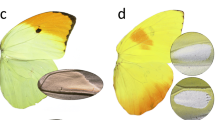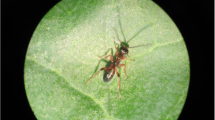Abstract
Neotropical Heliconius butterflies are members of various mimicry rings characterized by diverse colour patterns. In the present study we investigated whether a similar diversity is observed in the chemistry of volatile compounds present in male wing androconia. Recent research has shown that these androconia are used during courting of females. Three to five wild-caught male Heliconius individuals of 17 species and subspecies were analyzed by GC/MS. Most of the identified compounds originate from common fatty acids precursors, including aldehydes, alcohols, acetates or esters preferentially with a C18 and C20 chain, together with some alkanes. The compounds occurred in species-specific mixtures or signatures. For example, octadecanal is characteristic for H. melpomene, but variation in composition between the individuals was observed. Cluster analysis of compound occurrence in individual bouquets and analyses based on biosynthetic motifs such as functional group, chain length, or basic carbon-backbone modification were used to reveal structural patterns. Mimetic pairs contain different scent bouquets, but also some compounds in common, whereas sympatric species, both mimetic and non-mimetic, have more distinct compound compositions. The compounds identified here may play a role in mate choice thus helping maintain species integrity in a butterfly genus characterized by pervasive interspecific gene flow.




Similar content being viewed by others
Notes
Compounds occurring in only one sample analyzed are not listed in the tables of the main text because they were not included in the cluster analysis. However, SM Table S1 shows all identified compounds.
The character ω denotes the aliphatic end of an aliphatic chain, while Δ is counted from the carboxylate head group.
ile Δ is counted from the carboxylate head group.
References
Albre J, Liénard MA, Sirey TM, Schmidt S, Tooman LK, Carraher C, Greenwood DR, Löfstedt C, Newcomb RD (2012) Sex pheromone evolution is associated with differential regulation of the same desaturase gene in two genera of leafroller moths. PLoS Genet 8:e1002489
Andersson J, Borg-Karlson AK, Wiklund C (2000) Sexual cooperation and conflict in butterflies: a male-transferred anti-aphrodisiac reduces harassment of recently mated females. Proc R Soc Lond B 267:1271–1275
Ando T, Inomata S-I, Yamamoto M (2004) Lepidopteran sex pheromones. In: Schulz S (ed) The chemistry of pheromones and other Semiochemicals I. Springer, Berlin Heidelberg, pp 51–96
Bacquet PMB, Brattström O, Wang H-L, Allen CE, Löfstedt C, Brakefield PM, Nieberding CM (2015) Selection on male sex pheromone composition contributes to butterfly reproductive isolation. Proc R Soc Lond B 282:20142734
Bates HW (1862) Contributions to an insect fauna of the Amazon valley. Lepidoptera: Heliconidae. Trans Linn Soc London 23:495–566
Becker HGO, Beckert R (2004) Organikum: Organisch-chemisches Grundpraktikum, 22nd edn. Wiley-VCH, Weinheim, p 540
Becker LC, Bergfeld WF, Belsito DV, Hill RA, Klaassen CD, Liebler D, Marks JG, Shank RC, Slaga TJ, Snyder PW, Andersen FA (2012) Safety assessment of alkyl benzoates as used in cosmetics. Int J Toxicol 31:342S–372S
Beltrán M, Jiggins CD, Brower AVZ, Bermingham E, Mallet JLB (2007) Do pollen feeding, pupal mating and larval gregariousness have a single origin in Heliconius butterflies? Inferences from multilocus DNA sequence data. Biol J Linn Soc 92:221–239
Bestmann HJ, Kern F, Schäfer D, Witschel MC (1992) 3,4-Dihydroisocoumarins, a new class of Ant Trail pheromones. Angew Chem Int Ed 31:795–796
Blomberg SP, Garland T Jr, Ives AR, Crespi B (2003) Testing for phylogenetic signal in comparative data: behavioral traits are more labile. Evolution 57:717–745
Buser HR, Arn H, Guerin P, Rauscher S (1983) Determination of double bond position in mono-unsaturated acetates by mass spectrometry of dimethyl disulfide adducts. Anal Chem 55:818–822
Chouteau M, Arias M, Joron M (2016) Warning signals are under positive frequency-dependent selection in nature. Proc Natl Acad Sci U S A 113:2164–2169
Davey JW, Chouteau M, Barker SL, Maroja L, Baxter SW, Simpson F, Joron M, Mallet J, Dasmahapatra KK, Jiggins CD (2016) Major improvements to the Heliconius melpomene genome assembly used to confirm 10 chromosome fusion events in 6 million years of butterfly evolution. G3:g3-115
Ðorđević BS, Pljevljakušić DS, Šavikin KP, Stević TR, Bigović DJ (2014) Essential oil from blackcurrant buds as chemotaxonomy marker and antimicrobial agent. Chem Biodivers 11:1228–1240
Eisner J, Meinwald J (1987) Alkaloid-derived pheromones and sexual selection in Lepidoptera. Pheromone Biochemistry. Academic Press, Orlando
Estrada C, Jiggins CD (2008) Interspecific sexual attraction because of convergence in warning colouration: is there a conflict between natural and sexual selection in mimetic species? J Evol Biol 21:749–760
Estrada C, Yildizhan S, Schulz S, Gilbert LE (2010) Sex-specific chemical cues from immatures facilitate the evolution of mate guarding in Heliconius butterflies. Proc R Soc Lond B 277:407–413
Estrada C, Schulz S, Yildizhan S, Gilbert LE (2011) Sexual selection drives the evolution of antiaphrodisiac pheromones in butterflies. Evolution 65:2843–2854
Francke W, Schulz S, Sinnwell V, König WA, Roisin Y (1989) Epoxytetrahydroedulan, a New Terpenoid from the Hairpencils of Euploea (Lep.: Danainae) Butterflies. Liebigs Ann Chem:1195–1201
Friendly M, Fox J, Friendly MM (2016) candisc: Visualizing generalized canonical discriminant and canonical correlation analysis. R package version 0.7-2
Gilbert LE (1976) Postmating female odor in Heliconius butterflies: a male-contributed antiaphrodisiac? Science 193:419–420
Giraldo N, Salazar C, Jiggins CD, Bermingham E, Linares M (2008) Two sisters in the same dress: Heliconius cryptic species. BMC Evol Biol 8:324
Hammer Ø, Harper DA, Ryan PD (2001) PAST-palaeontological statistics, ver. 1.89. Palaeontol. electronica 4
Honda Y, Honda K, Omura H (2006) Major components in the hairpencil secretion of a butterfly, Euploea mulciber (Lepidoptera, Danaidae): their origins and male behavioral responses to pyrrolizidine alkaloids. J Insect Physiol 52:1043–1053
Jiggins CD (2008) Ecological speciation in mimetic butterflies. Bioscience 58:541–548
Kozak KM, Wahlberg N, Neild AFE, Dasmahapatra KK, Mallet J, Jiggins CD (2015) Multilocus species trees show the recent adaptive radiation of the mimetic Heliconius butterflies. Syst Biol 64:505–524
Kunesch G, Zagatti P, Pouvreau A, Cassini R (1987) A fungal metabolite as the male wing gland pheromone of the bumble-bee wax moth, Aphomia sociella L. Z Naturforsch 42c:657–659
Lassance J-M, Liénard MA, Antony B, Qian S, Fujii T, Tabata J, Ishikawa Y, Löfstedt C (2013) Functional consequences of sequence variation in the pheromone biosynthetic gene pgFAR for Ostrinia moths. Proc Natl Acad Sci U S A 110:3967–3972
Liénard MA, Wang H-L, Lassance J-M, Löfstedt C (2014) Sex pheromone biosynthetic pathways are conserved between moths and the butterfly Bicyclus anynana. Nat Commun 5:3957
Mallet J, Barton NH (1989) Strong natural selection in a warning-color hybrid zone. Evolution 43:421–431
McMillan WO, Jiggins CD, Mallet J (1997) What initiates speciation in passion-vine butterflies? Proc Natl Acad Sci U S A 94:8628–8633
Meinwald J, Meinwald YC, Wheeler JW, Eisner T, Brower LP (1966) Major components in the exocrine secretion of a male butterfly Lycorea. Science 151:583–585
Mérot C, Mavárez J, Evin A, Dasmahapatra KK, Mallet J, Lamas G, Joron M (2013) Genetic differentiation without mimicry shift in a pair of hybridizing Heliconius species (Lepidoptera: Nymphalidae). Biol J Linn Soc 109:830–847
Mérot C, Frérot B, Leppik E, Joron M (2015) Beyond magic traits: multimodal mating cues in Heliconius butterflies. Evolution 69:2891–2904
Merrill RM, van Schooten B, Scott JA, Jiggins CD (2011) Pervasive genetic associations between traits causing reproductive isolation in Heliconius butterflies. Proc R Soc Lond B 278:511–518
Merrill RM, Naisbit RE, Mallet J, Jiggins CD (2013) Ecological and genetic factors influencing the transition between host-use strategies in sympatric Heliconius butterflies. J Evol Biol 26:1959–1967
Merrill RM, Dasmahapatra KK, Davey JW, Dell'Aglio DD, Hanly JJ, Huber B, Jiggins CD, Joron M, Kozak KM, Llaurens V (2015) The diversification of Heliconius butterflies: what have we learned in 150 years? J Evol Biol 28:1417–1438
Miyakado M, Meinwald J, Gilbert LE (1989) (R)-(Z,E)-9,11-Octadecadienolide: an intriguing lactone from Heliconius pachinus (Lepidoptera). Experientia 45:1006–1008
More JD, Finney NS (2002) A simple and advantageous protocol for the oxidation of alcohols with o-iodoxybenzoic acid (IBX). Org Lett 4:3001–3003
Morgan ED (2010) Biosynthesis in insects, 2nd edn. Royal Society of Chemistry, Cambridge
Muñoz AG, Salazar C, Castaño J, Jiggins CD, Linares M (2010) Multiple sources of reproductive isolation in a bimodal butterfly hybrid zone. J Evol Biol 23:1312–1320
Nieberding CM, de Vos H, Schneider MV, Lassance J-M, Estramil N, Andersson J, Bång J, Hedenström E, Löfstedt C, Brakefield PM, Somers M (2008) The male sex pheromone of the butterfly Bicyclus anynana: towards an evolutionary analysis. PLoS One 3:e2751
Nieberding CM, Fischer K, Saastamoinen M, Allen CE, Wallin EA, Hedenström E, Brakefield PM (2012) Cracking the olfactory code of a butterfly: the scent of ageing. Ecol Lett 15:415–424
Nishida R, Baker TC, Roelofs WL (1982) Hairpencil pheromone components of male oriental fruit moths, Grapholita molesta. J Chem Ecol 8:947–959
Nishida R, Schulz S, Kim CS, Fukami H, Kuwahara Y, Honda K, Hayashi N (1996) Male sex pheromone of a giant danaine butterfly, Idea leuconoe. J Chem Ecol 22:949–972
Pagel M (1999) Inferring the historical patterns of biological evolution. Nature 401:877–884
Pankewitz F, Hilker M (2008) Polyketides in insects: ecological role of these widespread chemicals and evolutionary aspects of their biogenesis. Biol Rev 83:209–226
Pinheiro J, Bates D, DebRoy S, Sarkar D and R Core Team (2017) nlme: Linear and Nonlinear Mixed Effects Models. R package version 3.1-131
Pliske TE, Eisner T (1969) Sex pheromone of the queen butterfly: biology. Science 164:1170–1172
Revell LJ (2012) Phytools: an R package for phylogenetic comparative biology (and other things). Methods Ecol Evol 3:217–223
Rosser N, Phillimore AB, Huertas B, Willmott KR, Mallet J (2012) Testing historical explanations for gradients in species richness in heliconiine butterflies of tropical America. Biol J Linn Soc 105:479–497
Schulz S (1987) Die Chemie der Duftorgane männlicher Lepidopteren. Dissertation, University of Hamburg, Hamburg
Schulz S (2001) Composition of the silk lipids of the spider Nephila clavipes. Lipids 36:637–647
Schulz S, Francke W, Boppré M (1988a) Carboxylic acids from hairpencils of male Amauris butterflies (Lep.: Danainae). Biol Chem Hoppe Seyler 369:633–638
Schulz S, Francke W, Edgar JA, Schneider D (1988b) Volatile compounds from Androconial organs of Danaine and Ithomiine butterflies. Z Naturforsch sect C. J Biosci 43c:99–104
Schulz S, Beccaloni G, Nishida R, Roisin YR, Vane-Wright I, McNeil JN (1998) 2,5-Dialkyltetrahydrofurans, common components of the cuticular lipids of Lepidoptera. Z Naturforsch 53c:107–116
Schulz S, Beccaloni G, Brown KS Jr, Boppre M, Freitas AVL, Ockenfels P, Trigo JR (2004) Semiochemicals derived from pyrrolizidine alkaloids in male ithomiine butterflies (Lepidoptera: Nymphalidae Ithomiinae). Biochem Syst Ecol 32:699–713
Schulz S, Yildizhan S, Stritzke K, Estrada C, Gilbert LE (2007) Macrolides from the scent glands of the tropical butterflies Heliconius cydno and Heliconius pachinus. Org Biomol Chem 5:3434–3441
Schulz S, Estrada C, Yildizhan S, Boppré M, Gilbert LE (2008) An antiaphrodisiac in Heliconius melpomene butterflies. J Chem Ecol 34:82–93
Schulz S, Yildizhan S, van Loon JJA (2011) The biosynthesis of hexahydrofarnesylacetone in the butterfly Pieris brassicae. J Chem Ecol 37:360–363
Schwander T, Arbuthnott D, Gries R, Gries G, Nosil P, Crespi B (2013) Hydrocarbon divergence and reproductive isolation in Timema stick insects. BMC Evol Biol 13:151
Takahashi A, Tsaur S-C, Coyne JA, Wu CI (2001) The nucleotide changes governing cuticular hydrocarbon variation and their evolution in Drosophila melanogaster. Proc Natl Acad Sci U S A 98:3920–3925
Turner JRG (1976) Adaptive radiation and convergence in subdivisions of the butterfly genus Heliconius (Lepidoptera: Nymphalidae). Zool J Linnean Soc 58:297–308
Wang H-L, Brattström O, Brakefield PM, Francke W, Löfstedt C (2014) Identification and biosynthesis of novel male specific esters in the wings of the tropical butterfly, Bicyclus martius sanaos. J Chem Ecol 40:549–559
Yildizhan S, van Loon J, Sramkova A, Ayasse M, Arsene C, ten Broeke C, Schulz S (2009) Aphrodisiac pheromones from the wings of the small cabbage white and large cabbage white butterflies, Pieris rapae and Pieris brassicae. Chembiochem 10:1666–1677
Acknowledgements
CS, CPD and ML were funded by the FIUR fund QDN-DG001. CC was funded by a Smithsonian Tropical Research Institute short term fellowship and the Torkel Weis-Fogh and Balfour-Browne Funds. CJ was funded by an ERC grant ‘SpeciationGenetics’ 339873.
Author information
Authors and Affiliations
Corresponding author
Rights and permissions
About this article
Cite this article
Mann, F., Vanjari, S., Rosser, N. et al. The Scent Chemistry of Heliconius Wing Androconia. J Chem Ecol 43, 843–857 (2017). https://doi.org/10.1007/s10886-017-0867-3
Received:
Revised:
Accepted:
Published:
Issue Date:
DOI: https://doi.org/10.1007/s10886-017-0867-3




